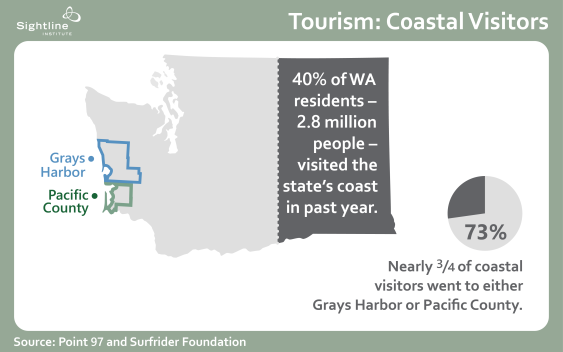Three large oil terminals proposed for Grays Harbor could undermine the region’s economy and local culture. That’s the takeaway from two recent economic analyses: first, a study on coastal recreation in Washington from the Surfrider Foundation and marine technology firm Point 97; then, Economic Impacts of Crude Oil Transportation on the Quinault Indian Nation and the Local Economy, published by economic consulting firm Resource Dimensions.
These reports help clarify the real threat that oil transport poses to Grays Harbor. But since most people don’t have the time to thumb through such detailed findings, Sightline commissioned the following graphics to sum up the key points.
Over forty percent of Washington residents travel to the coast each year; their top recreational activities are beachgoing, scenic enjoyment, wildlife viewing, photography, and hiking/biking.

Original Sightline Institute graphic, available under our free use policy. Data Source: Surfrider Foundation.
Coastal visitors spend an estimated $481 million dollars per year on recreation and tourism trips. An oil spill in the bay could do tremendous harm to businesses that are dependent on tourism dollars.

Original Sightline Institute graphic, available under our free use policy. Data Source: Surfrider Foundation.
The proposed oil projects could also have a devastating impact on fishing and tourism for the Quinault Indian Nation, as they have in the past: Quinault lands were oiled during the 1988 Nestucca oil spill at the mouth of Grays Harbor.

Original Sightline Institute graphic, available under our free use policy. Data Source: Resource Dimensions.
An increased volume of oil going into and out of Grays Harbor would increase the risk of spills, so Resource Dimensions studied three oil spill scenarios.

Original Sightline Institute graphic, available under our free use policy. Data Source: Resource Dimensions.

Original Sightline Institute graphic, available under our free use policy. Data Source: Resource Dimensions.
Quinault fishers’ catches and harvest include salmon, rockfish, white sturgeon, halibut, sardines, Dungeness crab, and razor clams.

Original Sightline Institute graphic, available under our free use policy. Data Source: Resource Dimensions.
Fishing and select Quinault businesses, mainly in the tourism industry, generate 668.5 direct jobs. Purchases made by these businesses generate $84.7 million in revenues for suppliers and support 239 other jobs in the region.

Original Sightline Institute graphic, available under our free use policy. Data Source: Resource Dimensions.
Resource Dimensions analyzed the potential for job losses, personal income declines, and missed business revenue that would result from the possible spill scenarios.

Original Sightline Institute graphic, available under our free use policy. Data Source: Resource Dimensions.
A loss of jobs and income would be particularly devastating for the Quinault reservation, where the median income is half that of Washington as a whole.

Original Sightline Institute graphic, available under our free use policy. Data Source: Resource Dimensions.
An estimated 1,380 Quinault Indian Nation members rely on subsistence fishing and harvesting, which makes up about 20% of their diet.

Original Sightline Institute graphic, available under our free use policy. Data Source: Resource Dimensions.
If subsistence harvesting were unavailable due to an oil spill, the cost of replacing the lost protein content in the diet would be $260.16 per person per year. Since the average family size on the reservation is 3.74 people, replacing protein content would cost the average family $1,040.64 per year.

Original Sightline Institute graphic, available under our free use policy. Data Source: Resource Dimensions.
Even if no spill occurs, there will still be income losses. Lost fishing time from increased train traffic and marine vessels could cost a fisher up to $1,185 per year. Moreover, fishing nets can be damaged by propellers or oil spilled during regular business, costing a hefty $2,500 to replace.

Original Sightline Institute graphic, available under our free use policy. Data Source: Resource Dimensions.
A Grays Harbor oil spill would also impact tribal weavers, who make goods including baskets, jewelry, and clothing.

Original Sightline Institute graphic, available under our free use policy. Data Source: Resource Dimensions.
These two studies provided valuable data on the economic impacts of an oil spill at Grays Harbor and highlighted what is at stake beyond financial loss. Because it’s difficult to assign a market value to the human impacts of oil spills, they are all too often ignored.
Thanks to Devin Porter at Goodmeasures.biz, who designed these graphics.









Bill Adams
Excellent coverage. Too bad it can’t be on the front page of the Seattle Times. Anyway, keep up the good work and thanks for sharing.
Al B.
Superb as usual. Thanks for this. Re-sharing on various social media.
Richard Wm.Narlian
Contact a journalist with some national credibility.
Steve Loperz , Mike Royoko………and get them on your side.
The Pen still works.
Peter Holcomb
The only way to avoid a disaster in Grays Harbor is to forbid the port from transporting oil or allowing it to be transported.
Kyler Brown
I am doing some research into oil spills, and I found this article very interesting. I had never heard of the Grays Harbor oil spill, but this gave me some great information. There is always so much complaining that follows oil spills, and rarely little focus on how we can clean up the problem, so I appreciated this article. Thanks for sharing this.
Tim
May I use this article in a portfolio i’m putting together to take to each city’s counsel and have then sign to thwart Westway’s greed?